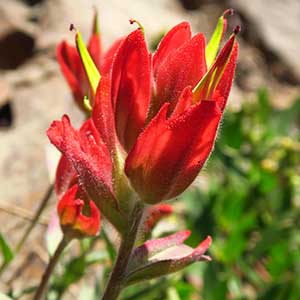Castilleja chambersii
Castilleja elmeri
Chambers' Indian paintbrush, Chambers' paintbrush
Elmer's Indian paintbrush, Elmer's paintbrush, Wenatchee Indian paintbrush, Wenatchee paintbrush
solitary or few to several, ascending, sometimes short-decumbent and rooting, branched from near base, sometimes distally, glabrous or glabrate with hairs very sparse, ± appressed, very short, soft, eglandular.
solitary or few to many, erect to ascending, sometimes slightly curved at base, unbranched, rarely branched, hairs moderately dense, spreading, medium length, soft, mixed with shorter eglandular and stipitate-glandular ones, at least on distal 1/2 of stem.
green, often brown- or purple-tinged, oblong to lanceolate to narrowly ovate or ovate, (1–)2–5.8 cm, not fleshy, margins plane, ± involute, deeply 3–7(–11)-lobed, sometimes with secondary lobes, apex narrowly acute;
lobes erect to ascending, lanceolate to linear-lanceolate to oblanceolate, apex acute.
green, rarely purple-tinged, linear-lanceolate, sometimes linear or lanceolate, 1.3–6.5 cm, not fleshy, margins plane, flat or involute, entire, apex acute.
3–15 × 2–4.5 cm;
bracts proximally greenish, distally bright red, scarlet, or pale reddish orange, rarely orange-yellow, often fading to pale yellowish orange with age, obovate to orbicular, fan-shaped, (3–)5–9(–13)-lobed, sometimes with secondary lobes;
lobes erect or ascending, lanceolate to triangular, short and medium length, usually arising at or above mid length, rarely below, apex acute.
2.5–9 × 1.5–3 cm;
bracts red, crimson, scarlet, pink, magenta, red-orange, burnt orange, orange, pale yellow, or whitish throughout, or proximally greenish, distally as stated above, oblong, narrowly obovate, elliptic-oblong, or narrowly ovate, 0(–5)-lobed, rarely with 1 or 2 pairs of short, usually distal lobes;
lobes ascending, lanceolate, very short, arising from distal edge, apex rounded to obtuse.
0 mm.
straight, 30–45 mm;
tube 14–19 mm;
beak long-exserted, adaxially green or yellow-green to brownish, 18–24 mm;
abaxial lip deep green, reduced, 1–3 mm, 10% as long as beak;
teeth incurved, greenish to dull purplish, 0.5–1.5 mm.
straight, 20–33 mm;
tubes 13–18 mm;
beak, and sometimes abaxial lip, partially to fully exserted;
beak adaxially green to yellowish, 8–15 mm;
abaxial lip incurved, green, thickened, 2–3 mm, 20–33% as long as beak;
teeth ascending or incurved, green, 0.5–1 mm.
proximally green, sometimes purple to brown, distally colored as bracts, 20–30 mm;
abaxial and adaxial clefts 7–14 mm, ca. 33% of calyx length, deeper than laterals, lateral 2–4 mm, 10–15% of calyx length;
lobes triangular, barely longer than wide, apex acute or acuminate to obtuse.
proximally green to pale green, distally colored as bracts, 15–25 mm;
abaxial and adaxial clefts 5–14 mm, 33–50% of calyx length, deeper than laterals, lateral 1–4 mm, 6–20% of calyx length;
lobes lanceolate to narrowly triangular, apex rounded to obtuse.
= 24.
= 48.
Castilleja chambersii
Castilleja elmeri
Castilleja chambersii is limited to the summits of three volcanic peaks in the northern Coast Range of Clatsop County, Oregon, and at one similar area in nearby Pacific County, Washington. It is similar to C. rupicola, and the two likely share a common ancestor. Disturbance and erosion from logging and road construction represent significant threats to C. chambersii. Populations of C. chambersii often grow near and even alongside C. hispida, but hybrids are rare.
(Discussion copyrighted by Flora of North America; reprinted with permission.)
The bracts and inflorescences of Castilleja elmeri can be red, crimson, scarlet, pink, magenta, red-orange, burnt orange, orange, pale yellow, or whitish. While the coloration is highly variable between local populations, it is usually uniform and consistent within them. It is found primarily in the Wenatchee Mountains of Washington, where it is often on serpentine, but it ranges northward in the Cascades into extreme southern British Columbia, apparently on non-serpentine substrates. Hybrids with C. miniata var. miniata, C. parviflora var. albida, and C. thompsonii have been found in the eastern Cascades of Washington, and a similar hybrid swarm with C. thompsonii is reported from southern British Columbia.
(Discussion copyrighted by Flora of North America; reprinted with permission.)



